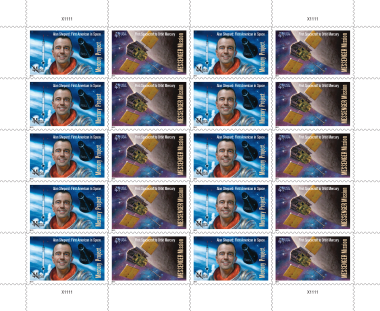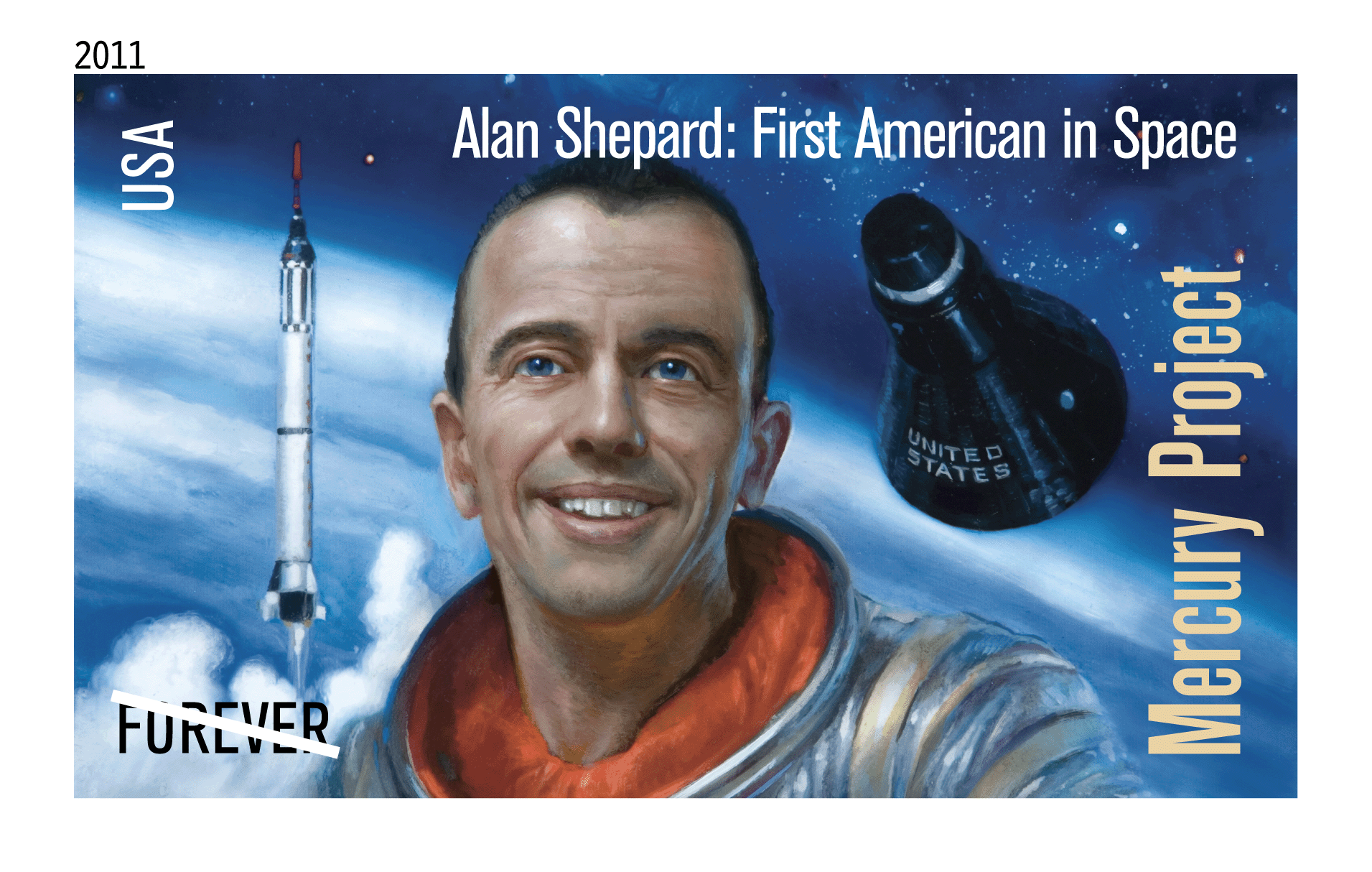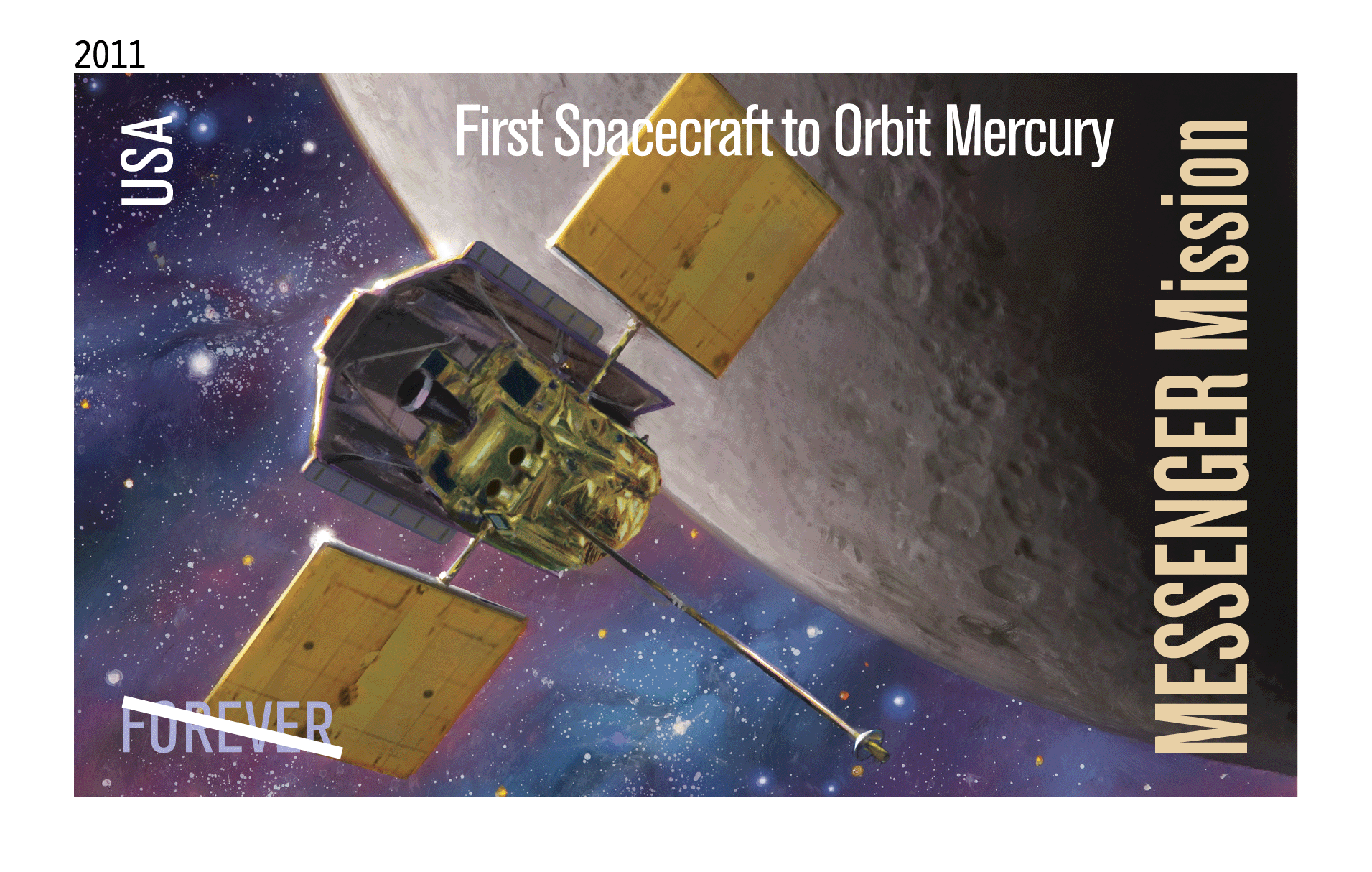
About This Stamp
In 2011, the U.S. Postal Service issued two stamps in recognition of advances in space exploration. One stamp commemorates NASA’s first manned spaceflight program and astronaut Alan Shepard’s historic flight aboard the Mercury spacecraft Freedom 7 on May 5, 1961. The other stamp draws attention to NASA’s unmanned MESSENGER mission, a scientific investigation of the planet Mercury. On March 17, 2011, MESSENGER became the first spacecraft to enter into orbit around Mercury.
In 1959, NASA selected the nation’s first astronauts. Two years later Alan Shepard blasted off from Cape Canaveral, Florida. His flight reached a maximum speed of 5,100 miles per hour, roughly eight times the speed of sound, and a zenith of 116 miles above the Earth. With parachutes deploying, his capsule splashed down in the Atlantic some 300 miles from the launch site. The New York Times declared that Shepard’s 15-minute flight “roused the country to one of its highest peaks of exultation since the end of World War II.”
The insertion of MESSENGER (MErcury Surface, Space ENvironment, GEochemistry, and Ranging) into orbit around Mercury in March 2011 represents a major milestone in space exploration. The data obtained by MESSENGER may tell us how the planet took shape and also offer clues about the origin of our solar system. The first images that have come back to Earth have been spectacular. They, along with “the first measurements from MESSENGER’s other payload instruments, are only the opening trickle of the flood of new information that we can expect over the coming year,” according to MESSENGER Principal Investigator Sean Solomon.
Award-winning illustrator Donato Giancola, under the direction of Phil Jordan, illustrated both stamps based on NASA photographs and images.
The Mercury Project and MESSENGER Mission stamps are being issued in panes of 20 self-adhesive Forever® stamps. Forever stamps are always equal in value to the current First-Class Mail one-ounce rate.
Stamp Art Director, Stamp Designer

Phil Jordan
Phil Jordan grew up in New Bern, North Carolina, and attended East Carolina University. After Army service in Alaska, he graduated from Virginia Commonwealth University with a degree in visual communications. He worked in advertising and in design at a trade association before joining Beveridge and Associates, Inc., where he provided art direction for corporate, institutional, and government design projects. A partner in the firm, he left after 18 years to establish his own design firm where he managed projects for USAir, NASA, McGraw-Hill, IBM, and Smithsonian Books, among others. He was Design Director of Air & Space/Smithsonian magazine for 15 years. His work appeared in numerous exhibitions and publications such as Graphis and Communications Arts. A past president of the Art Directors Club of Metropolitan Washington, he was an art director for the U.S. Postal Service from 1991 to 2014. A resident of Falls Church, Virginia, he is a retired glider pilot and a member of the Skyline Soaring Club.
Stamp Artist

Donato Giancola
Born in 1967 and raised in Colchester, Vermont, Donato Giancola earned a bachelor of fine arts in painting from Syracuse University. His education continued in New York City as studio assistant to American realist painter Vincent Desiderio and through pilgrimages to museums of art around Europe.
Giancola began his career as a freelance illustrator in the early 1990s. Primarily working with science fiction and fantasy subjects, he has illustrated hundreds of book covers, game art and magazines, balancing modern concepts with realism to bridge the worlds of figurative and commercial arts.
His list of clients has included the United Nations, LucasArts, National Geographic, CNN, Microsoft, Simon & Schuster, Random House, Milton-Bradley, and Hasbro. A recently released 200 page tome from Dark Horse Books of his illustrations on J.R.R. Tolkien's The Lord of the Rings and The Hobbit lists among his greatest professional successes.
Giancola has received many awards for his art including the Hamilton King Award from the Society of Illustrators (2008), twenty-three Chesley Awards from the Association of Science Fiction and Fantasy Artists, three Hugo Awards for Best Professional Artist from the World Science Fiction Society, numerous awards from the Art Renewal Center's International Salons, and multiple silver and gold medals from the juried annual Spectrum: The Best of Contemporary Fantastic Art.
Giancola teaches at the Illustration Master Class, online through the SmArt School, and appears at various institutions, workshops, and conventions around the world, where he performs demonstrations in oil painting and lectures on his aesthetics.
His studio is in his home in Brooklyn, New York, where he lives with his wife and two daughters. His first illustrations for the U.S. Postal Service, featured in the Mercury Project & MESSENGER Mission (2011) stamp issuance, was followed by his portrait of Ursula K. Le Guin for the 2021 Literary Arts stamp issuance.

